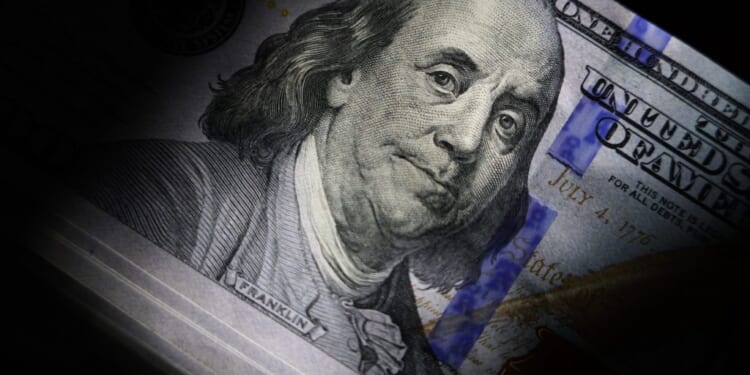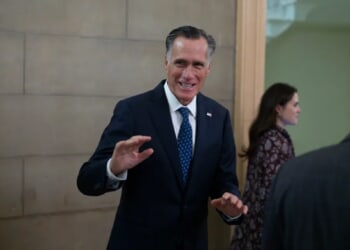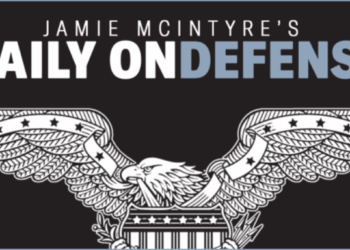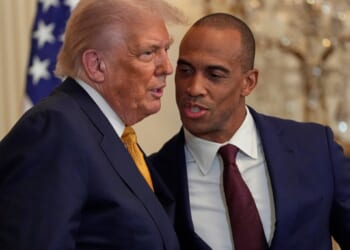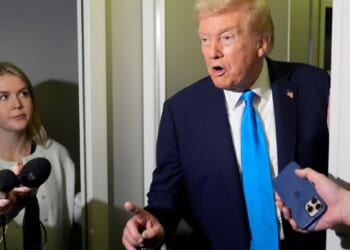In Focus delivers deeper coverage of the political, cultural, and ideological issues shaping America. Published daily by senior writers and experts, these in-depth pieces go beyond the headlines to give readers the full picture. You can find our full list of In Focus pieces here.
The following is adapted from a speech delivered at the Hillsdale College Free Market Forum in October.
We are reminded often of the great threat China poses to the West, and in June, we were told by certain pundits that the president’s actions in the Middle East would kick off World War III, a war America would lose. But history tells us that great nations like ours rarely fall to foreign invasion. Rome wasn’t conquered at its height. It collapsed under its own weight — debt, decadence, denial. Spain followed the same path. So did Britain.
Now, the United States carries more than $38 trillion in debt and adds over $2 trillion each year. We’re not unique because we have debt. We’re unique because we pretend the math doesn’t apply to us. Politicians insist we can always “print the money” or “grow our way out.” But debt has a way of deciding policy for you. You can ignore it, and then one day it stops being background noise and becomes the story. When that day comes, we’ll find out who’s really in charge: not the president or Congress, but the bond market.
JONI ERNST ANNOUNCES RETIREMENT, LEAVING IOWA SENATE SEAT OPEN FOR 2026
The great Austrian economist Ludwig von Mises wrote in his essay “Planning for Freedom,” “If it is unnecessary to adjust the amount of expenditure to the means available, there is no limit to the spending of the great god State.” Unfortunately, that is precisely where we are now. Washington spends about $6.5 trillion a year and brings in roughly $4.8 trillion in revenue. The difference, our deficit, is debt.
Interest payments alone will top $1.2 trillion this year — more than we spend on defense, more than Medicare, and soon more than Social Security itself. We’re literally borrowing money to pay the interest on money we already borrowed. That’s not sustainable math. It’s financial fantasy. And fantasies end badly.
This crisis isn’t driven by foreign aid or pet projects. It isn’t driven by any of the hot-button topics that we debate anytime there is a spending bill up for a vote. It’s driven by the programs politicians refuse to touch: Social Security, Medicare, and Medicaid.
Social Security will run out of reserves in fiscal year 2033, triggering an automatic 23% cut in benefits. Medicare Part A, Medicare’s hospital insurance fund, goes insolvent the same year. When that happens, the program will cover only 89% of promised benefits. Medicaid has no trust fund. It just grows, consuming an ever-larger share of federal spending. When these programs hit the wall, the party in power will be blamed.
It is not unreasonable to assume Democrats will have failed to get their act together in the next eight years. Fast forward to 2033. A conservative president — say, [Vice President] JD Vance — is sworn in for his second term, with a mandate. He won 38 states, both houses of Congress, and the popular vote, and he did it more convincingly than President Donald Trump did last year. He has big plans for the economy, the military, and the border. Then, boom. Social Security goes insolvent. Seniors’ checks drop 23%. Overnight, his administration is fighting a political wildfire.
It would be like what 9/11 did to George W. Bush’s presidency, or what the Great Depression did to Herbert Hoover’s — a defining crisis that consumes everything else. And like in those administrations, Washington will likely react badly and make matters worse.
Faced with a revolt from retirees, Congress will take the easy way out: print the money. The Federal Reserve will flood the system with liquidity to keep the checks flowing. At first, it’ll look painless — no hard votes, no angry town halls. But prices will start rising faster than wages. The dollar will weaken. Investors will lose faith in treasuries. Interest rates will climb, forcing the government to borrow even more just to pay for yesterday’s panic. The cycle will feed itself — higher prices, higher rates, lower confidence, repeat. That’s how Argentina and Venezuela turned from promising, middle-income economies into cautionary tales.
RESTORING AMERICA: TRUMP’S BET ON JAVIER MILEI PAYS OFF
We’ve already seen multiple warning signs this year. In April, treasury yields spiked, and Japan and China, two of our largest foreign creditors, stepped back from buying U.S. debt. One reason was market uncertainty over tariffs. Tariffs sound good if you don’t think about it very hard. They come with promises such as reshoring American manufacturing, which, of course, has not happened. Tariffs might raise a little revenue for the state, but they also raise prices, disrupt trade, and spook creditors. When creditors get nervous, they buy fewer treasuries. Fewer buyers mean higher yields, bigger deficits, and more borrowing.
April wasn’t the only warning sign. Gold just broke $4,000 an ounce, the highest price in history, driven by a weakening dollar and global risk aversion. Gold doesn’t surge when people feel confident. It surges when trust is fraying. When gold breaks records and bond markets wobble, that’s not coincidence. It’s a siren. The markets are telling us the world is losing faith in our currency and our ability to pay down the debt.
When a conservative administration inherits this collapse, it will lose legitimacy overnight. Try securing the border, cutting waste, or rebuilding the military while inflation is accelerating and bond yields are in the double digits. Imagine finally attempting to reform the entitlement programs that caused this mess in a political climate like this. The crisis won’t just kill the dollar. It’ll make real reform impossible for another generation.
Step one is honesty. That means accepting some hard truths: Social Security and Medicare must be reformed, not “saved,” at least in the way both Democrats and the Trump administration use the word. You can’t grow your way out of $38 trillion in debt, especially while pretending tariffs and deficit spending are free. We need massive growth. Without it, there is no path forward. We need to get the boot of taxation off of the necks of America’s entrepreneurs, and we need radical deregulation. But growth alone will not end this crisis.
Step two is courage. Real reform makes it hard to win elections, but it can preserve a nation. We will, in fact, have to touch the “third rail” and do unpopular things. Yes, this means gradually raising eligibility ages, means-testing benefits, eliminating automatic spending growth, and building a tax system that rewards work, not debt.
I’m not sure how likely this is in the near-term, but we will need leaders who tell the truth: that a country that lives on borrowed money eventually lives on borrowed time. One of our greatest presidents, Warren G. Harding, told the people the truth: that it was not the government’s job to fix the economy during the Depression of 1920-1921, and the nation’s short-term sacrifices resulted in the largest peacetime economic boom in American history.
GOVERNMENT SHUTDOWN WILL ADD TO THE FEDERAL DEBT
I get pushback from [Make America Great Again] for talking “too much” about economics on my podcast and in articles here at the Washington Examiner and other publications. I hear complaints such as, “Brady, don’t you care about ‘X’?” Yes, I’m thrilled that the current administration has all but ended the border crisis. It is wonderful that Trump’s work in the Middle East has led to a ceasefire in the Gaza war and a diminished Iran. I don’t doubt that many in the Trump administration seek to fix what ails our nation, but unfortunately, you can’t fix the country if you don’t fix the money. And our money is broken.
America still has the most dynamic economy, the most trusted currency, and the deepest capital markets in the world. But none of that is guaranteed. When Rome fell, it wasn’t because the barbarians were at the gates. It was because the empire hollowed itself out. We still have time to choose a different ending. But not much. If we don’t, then one day soon, the bond market — the real ruler of America — will start making decisions for us.
Brady Leonard (@bradyleonard) is a musician, political strategist, and host of The No Gimmicks Podcast.

